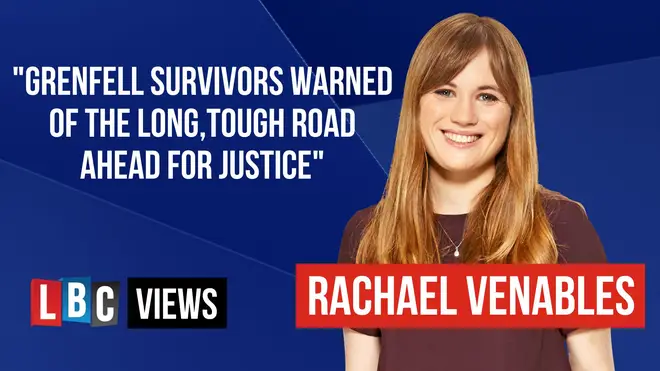
Shelagh Fogarty 1pm - 4pm
13 June 2022, 17:18

“It was the cladding, the new cladding.”
“It was the cladding, the new cladding.”
“The fire spread up the cladding like petrol!”
By the time I arrived at Grenfell in the early hours of the 14th June 2017, the tower was almost fully ablaze; a huge strip of flame running to the very top of the 24 storey building.
In interviews with the devastated residents and neighbours who were stood out on the street, watching it burn, they kept saying the same thing over and over: "it was the cladding."
I can remember struggling to fully understand what they meant, and indeed, not even those who’d seen it with their own eyes could comprehend how the fire had spread so quickly.
Neither, we now know, could the firefighters, and their lack of preparedness for such a scene led to the Chairman of the Grenfell Inquiry Sir Martin Moore-Bick to accuse the organisation of "systematic failings," in the conclusion of his Phase One report.
These failings ranged from communication breakdowns and poor equipment, to a lack of training on how to recognise a cladding fire.
But, most damning of all, was the fact they should have dropped their “stay put” advice for “get out” at some time between 1.30 and 1.50am.
Instead, they kept telling residents to stay in their flats until 2.47am, long after the corridors and single staircase had filled with so much smoke that evacuation was almost impossible.
That, according to Moore Bick, cost lives.
Today, in London alone, there are more than 1,000 blocks with fire issues so bad, that the fire brigade have dropped their "stay put" advice for evacuation plans.
But, the fire brigade were only put in that hellish position on the night, because Grenfell tower’s fire-stopping failed so spectacularly.
This included faults with the windows, fire doors and ventilation, but most harmful of all was the cladding, fixed to the outside of the building during a recent refurbishment.
It was the cladding, according to Sir Martin, that was the ‘primary cause of the fire spread’ with the insulation also contributing to the flames progression across the external walls of the tower, and into people’s flats.
Phase Two of the Inquiry is still on-going, but it has already shone light on a confusing and complex regulatory regime, with cladding maker Arconic, and insulation manufacturers Kingspan and Celotex able to use a loophole to market their flammable products as ‘safe’ for high rise buildings.
In 2001, a similar type of cladding to the one on Grenfell tower, spectacularly failed a fire test after just three minutes, with the resultant flames shooting 20 metres into the air.
The government was told about this test, but it did not ban the cladding, nor properly close the loophole.
In the aftermath of the fire, we learnt of hundreds of other buildings with similar cladding around the country, and today that has ballooned into a multi-billion pound building safety crisis, trapping hundreds of thousands in dangerous, un-sellable homes.
The problems found have not been limited to cladding, but also encompass insulation, wooden balconies, missing fire-breaks and a multitude of other safety defects in Britain’s housing stock.
LBC reported last week that the Government thinks some 9,793 buildings in England need remediation or mitigation, but they don’t know exactly how many because no one has ever done a proper survey to check.
In the years since the fire, more has also come to light about the more vulnerable residents at Grenfell Tower, who disproportionately perished in the disaster.
Of the 37 disabled people living at Grenfell, 15 lost their lives.
Sir Martin Moore-Bick recommended the owner and manager of every high-rise residential building be required “by law” to prepare ‘personal emergency evacuation plans’ for all residents less-able to self-evacuate, but last month the Government rejected that proposal as “not proportionate or practical.”
And finally, what of the criminal investigation?
I can tell you that five years ago the international outrage at the loss of life at Grenfell felt so acute, it was impossible to imagine anything other than rapid criminal retribution.
But five years on, there have been no relevant arrests.
In a statement released yesterday, Deputy Assistant Commissioner of the Metropolitan Police Stuart Cundy said more than 180 dedicated investigators have taken more than 9,000 witness statements, working through 130 million documents.
Forty people have been interviewed, some more than once, but Scotland Yard want to wait until the end of the Inquiry before considering arrests or charges.
That’s something Grenfell survivors and bereaved accepted once, but they tell me now they have run out of patience. They look at the amount we now know about the tragedy, compared with how little has changed, and see it as a chronic lack of impetus and justice.
Moreover, as we approached the five year anniversary, several residents told me they see similarities in their fight with that of the Hillsborough families.
In the aftermath of the tragedy, I’m told Hillsborough campaigners met Grenfell survivors, and warned them the fight for any sort of justice would be a long tough road.
And, as they mark five years since the night they lost everything, more and more Grenfell campaigners are seeing just how true those words were.